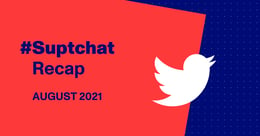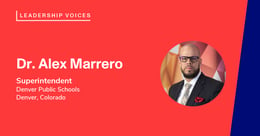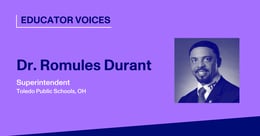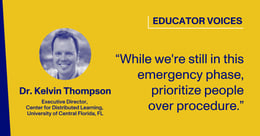
5 Reopening Secrets From Irvine USD, CA
Irvine Unified School District's Assistant Superintendent of Education Services, Cassie Parham, and Chief Technology Officer, Brianne Ford, recently spoke about their reopening plan and how Paper fits into their educational support strategy. This webinar was moderated by California IT in Education’s (CITE) Director of Education and Events, Laurel Nava.
What Led Irvine to Partner with Paper?
A commitment to equity
We've spent the last ten years focused on vehicles for promoting equity with students. One of our challenges is that we have high performing students, but we also have students who struggle, and sometimes the focus is more on the higher-performing students. We really wanted to flip that, and we wanted to ensure that we were meeting the needs of every student. What made Paper interesting to me was that: We know that we have plenty of kids that use tutors, and it's really those families that can afford them that utilize them. It was really intriguing to me the idea of providing tutors to every student and having it be a free service that was not only available to them 24/7, but they could get support in whatever discipline they needed. I know many of our parents struggle once the kids are out of primary to help their kids. Also, kids oftentimes, and we know especially how teenagers are wired, are seeking help at 11 o'clock at night, and there's no one there to help them.
Leveling the playing field
It was really exciting for me to think about a support system that could provide something for all kids at any time of night and give them the kind of targeted support that they need. There's so much that I could say, but that was sort of what intrigued me. It's like, let's level the playing field here. Let's ensure that every kid has access to high-quality tutors. Tutoring works, and as much as you sometimes hear that "well, they shouldn't need them" and "we don't want them," parents wouldn't pay for tutors if they didn't work. But the criticism you hear from teachers sometimes is that well, it's because the tutors are giving them the answers.
Highly qualified tutors
Well, with Paper, we have highly qualified tutors who are not providing answers. It's a Socratic dialogue. It's metacognitive. It's intended to have kids think about their thinking and come to the answers on their own just with prompting and guiding, and so we have quality control. We have a service for every student. They don't have to pay for it. It's always there for them. Like for me, it was just—it was a no-brainer. I wanted to get involved, and then the company was fantastic to work with, incredibly accessible and open and creative and willing to partner with us and listen to us and make changes based on things that we had shared.
— Cassie Parham, Assistant Superintendent of Education Services, Irvine USD
→ Watch how Irvine is fulfilling their commitment to equity with Paper
Anytime, Anywhere Supports
Late-night help requests
At the IT Help Desk, we get somewhere between 40 and 50,000 help desk tickets a year, and one of the ships that we were noticing in all of that is that the spread of when those come in at midnight, five o'clock in the morning is starting to increase. We have so many students who are requesting help late into the night, early in the morning, and so many staff that are struggling with feeling that they have to be "always on" and there for a caseload of almost 190 different students.
Help at their fingertips
Another issue on the equity focus is for students making the same mistakes over and over again, they're stuck on something in the middle of the night, and they try to power through it. So they're spending a crazy amount of time on this one thing and either consistently doing it incorrectly for the remainder of the assignment or just getting so frustrated and pouring time into something where they just need a little bit of support. Our concern was also the well-being of staff and students in this kind of "always on" environment. Is there something we can do that whenever somebody needs help, it's there at their fingertips?
— Brianne Ford, Chief Technology Officer, Irvine USD
Addressing IT Challenges
Loss of visibility and connection
It's been incredible, exhilarating, and also incredibly challenging and exhausting in the shift to distance learning for the IT team. When we went so abruptly into distance learning, it felt like a wall was erected between teachers and students. They lost a lot of that visibility into how the students were doing. Teachers were really great at making that effort, but there was such a sense of loss on both sides. As they did live instruction, there were connectivity issues, device access issues, and just "how-to" issues. We had parents still working and kindergartners trying to navigate how to jump on a Google Meet on their own at home. At the high school level, you're missing that sacred window of the content, and the instruction and students were suddenly behind and feeling disconnected.
Catch-all safety net
In addition to all of the efforts Cassie's team and our EdTech team were doing, I think Paper was great as that sort of catch-all safety net. If students missed 15 minutes of instruction and they were just missing that one core skill to solve a problem, they could connect with Paper. If they wanted to have an essay reviewed, not just for grammatical and spelling checks that you can get through typical online services, but for the attentiveness to the rubric, the strength of the argument, they had Paper as that extra resource.
— Brianne Ford, Chief Technology Officer, Irvine USD
[To hear more from the Irvine USD Leadership, watch the webinar recording here.]
Changes to Instruction
Acting on survey feedback
We surveyed our parents and teachers to try to get a sense of what worked for them in emergency distance learning and what didn't. We learned from all of that feedback that we need to have more synchronous instruction; there needs to be tighter structure and schedules for students. I think one of the challenges is we made the shift really quickly, and teachers weren't actually in perfect coordination. They would have office hours kinds of experiences in the spring, but they weren't coordinated. So a kid had to choose between "do I want to talk to my math teacher or my science teacher?" Thus, even more reason why they would need to contact a tutor in the evening because they couldn't have that one-on-one with their teacher.
Launching a Virtual Academy
We're launching a Virtual Academy. Usually, that's something that would take years, and we're doing it in a matter of weeks, and we're excited about that. We're using that in conjunction with all of the courses the IUSD Blended learning courses that we've developed. We also have traditional models; we have a hybrid model—we have multiple education models that we'll be putting into place next week.
— Cassie Parham, Assistant Superintendent of Education Services, Irvine USD
More essay feedback, less teacher workload
Low-stakes opportunities
Anytime you can get more eyes on a paper, it's a good thing. We want students to be getting feedback, and we want them to have an opportunity to look from different perspectives at their papers. We do utilize our principals quite a bit at IUSD; we ask them to engage with their teachers and their departments and just talk about how things can be utilized. We also really believe in the pilot system, where you find a few people and ask them to try things. And so we did that in summer school in some of our EL classes. That was a great low-stakes opportunity for kids who are still learning the language to get feedback without a grade. We know that some of the best learning happens on low-stakes kinds of assignments, where kids don't feel threatened, so knowing they're going to get feedback and not a grade.
An asset for ELA teachers
As a former English teacher, I remember the weight of 170 papers from my 170 kids, and they were five pages each, and it was a month of correcting. And that was me working dutifully every single weekend to get through them. I did lots of peer editing—I did everything I could to get other people to look at these papers. But if I had Paper, I would have been from the get-go like: "I don't even want to look at it until you've uploaded it and gotten feedback. Show me that you've integrated it before I even look at that first draft." And that's the power of having that Socratic dialogue and having a tutor ask you questions rather than give you answers. It's such an obvious, valuable asset, and we are going to work hard to ensure that our kids are making the most use of it.
— Cassie Parham, Assistant Superintendent of Education Services, Irvine USD






